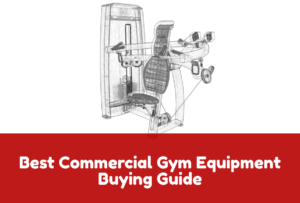You ever feel that hesitation? What if I pick the wrong equipment?
I’ve felt that too. I remember standing in a nearly finished gym, staring at a squat rack I had just installed. It looked fine but something didn’t sit right.
And I was right.
It wasn’t the best choice for that space. Or those clients.
If you’re debating between a power cage and a squat rack, this guide will help.
I’m writing this because I’ve made both choices. I’ve worked with gyms big and small. I’ve sold, installed, and trained with both pieces of equipment. And I’ve seen what works and what doesn’t. You’ll walk away knowing exactly what fits your needs.
Let’s start!
1. Quick Overview: What’s the Difference?
When I first started building gym spaces, I didn’t think too hard about racks.
A rack was a rack, right?
But the more setups I helped with, the more I realized:
Power cages and squat racks serve different needs. And if you choose the wrong one, you’ll feel it in daily training, space layout, and even safety.
Let’s break down what each one really is starting with the basics.
What is a Power Cage?
A power cage is like a personal lifting station. It’s a fully enclosed steel frame, usually made with four vertical posts.
Inside, you’ll find adjustable safety bars or straps. These are there to catch the barbell if you drop it. That alone makes a big difference for people lifting alone or pushing heavy.
Most power cages also come with extras:
- Pull-up bar
- Band pegs
- Dip handles
- Add-on attachments like cable pulleys or landmine rows
It’s built to handle a lot. And that’s part of its strength—and its size.
What is a Squat Rack?
A squat rack is more open. It usually has 2 upright posts with hooks to hold the barbell. Some versions come with a back base and safety arms, making it a bit more stable.
Compared to a power cage, a squat rack is:
- Lighter
- Easier to move
- Takes up less room
You still get solid support for squats and presses. But there’s less structure around you. That can be good—or bad depending on your gym setup and who’s using it.
Side-by-Side Comparison
Feature | Power Cage | Squat Rack |
Initial Price | Higher upfront cost due to size and materials | More affordable starting point |
Long-Term Value | Replaces multiple machines with add-ons | May need extra accessories to expand functionality |
Add-On Compatibility | Highly customizable: cables, dip bars, landmines, pull-ups, storage pegs | Limited: mostly spotter arms, J-hooks, and weight storage pegs |
Brand Flexibility | Many universal options, but some brands use exclusive parts | Fewer options and add-ons; check compatibility before purchasing |
Popularity | Widely used in Functional Training, strength gyms, and athletic training centers | Common in home gyms, smaller studios, and general fitness facilities |
User Type | Ideal for heavy lifters, group training, and varied movement needs | Best for casual lifters, beginners, or facilities with space limitations |
Training Options | Supports full-body training with compound and accessory movements | Mostly focused on basic barbell movements |
Upsell Potential (For Distributors) | Strong: more add-ons, higher margins, more bundle opportunities | Quick turnover, easy to store and ship |
Let’s now take all this side-by-side insight and break it down further.
2. Safety Comparison
Once, I watched a lifter miss a rep while squatting inside a power cage. The bar dropped fast but the safety bars caught it instantly. No injury. No panic. Just a quick reset and he walked away fine.
That’s why safety matters especially in a gym where people train alone or push heavy weight.
So, which setup gives you more protection: a power cage or a squat rack?
Let’s break it down.
Power Cage
A power cage is built for safety. It has safety pins or straps that sit just below your range of motion. If the bar drops, these will stop it before it hits the ground or you.
The enclosed frame also adds a layer of protection. You’re lifting inside a “box” that’s built to catch mistakes. That kind of setup gives a lot of peace of mind, especially to beginners or lifters training alone.
I’ve used power cages in commercial gyms, training studios, and even in small home setups.
No matter where it is, that extra structure makes a difference.
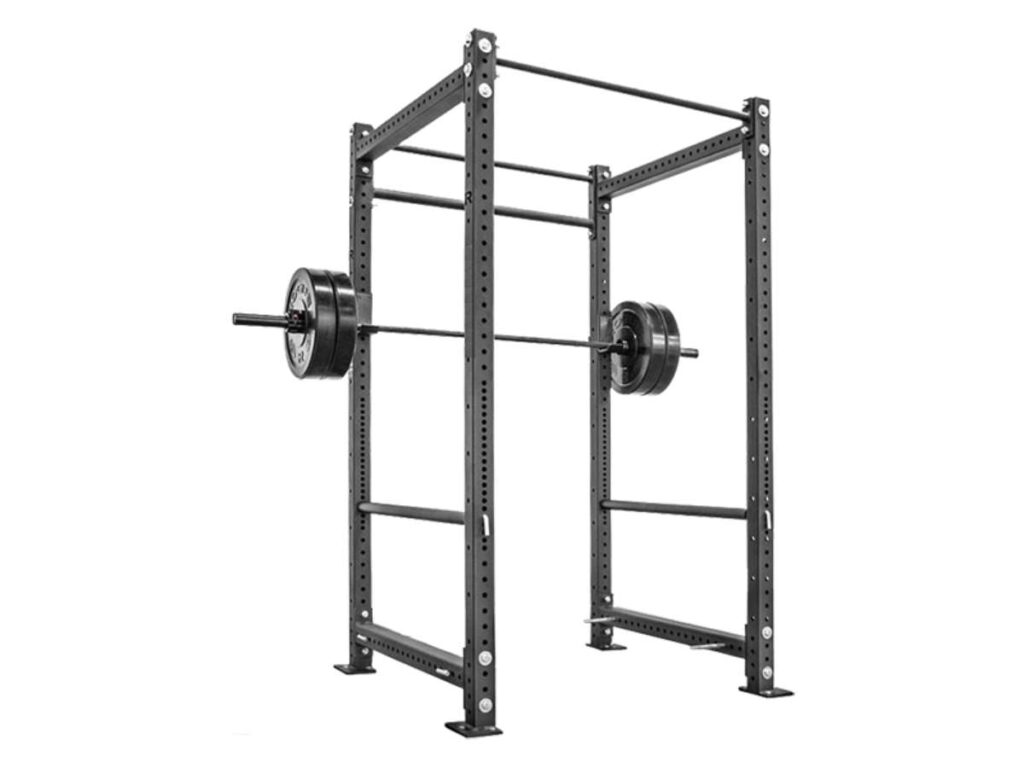
Squat Rack
Squat racks aren’t unsafe. But they ask more from the lifter.
There’s no enclosure, so you rely more on your form and experience. Some racks come with spotter arms, which help but they’re not foolproof. If they’re not set up right, they won’t help much.
This setup is best for lifters who:
- Know how to bail safely
- Lift with a partner
- Stay within comfortable weight ranges
Without that, the margin for error is smaller.
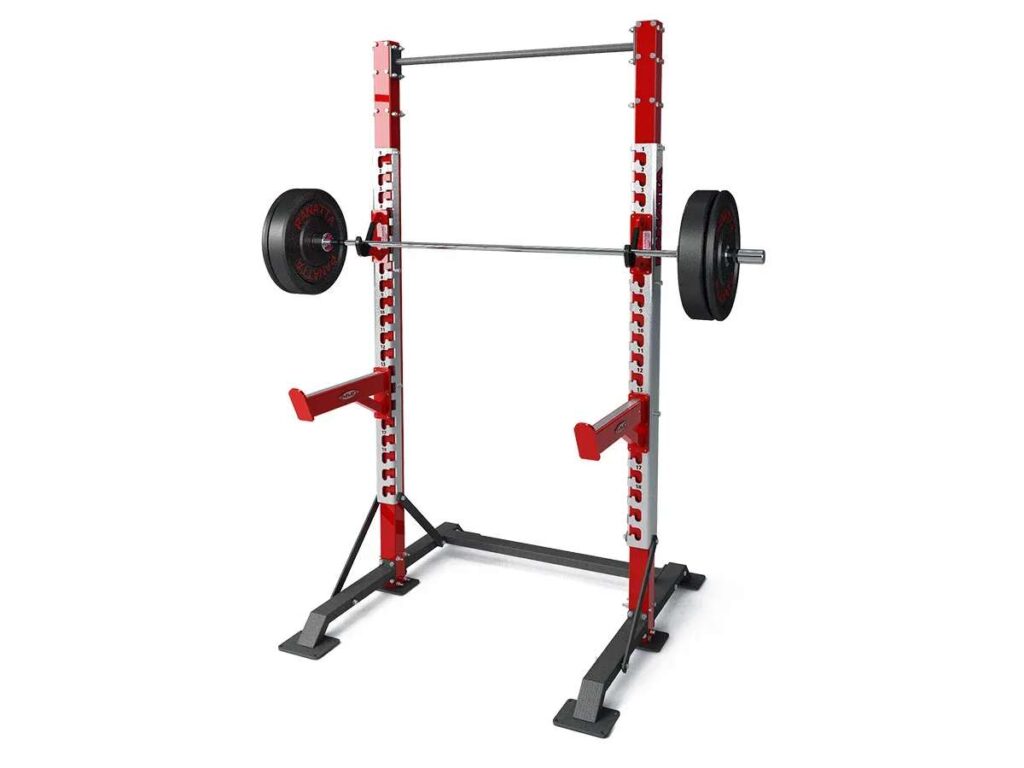
And here’s an important note for gym owners
Does your gym have a lot of solo lifters?
Do people train without supervision?
If so, a power cage adds an extra layer of protection. It keeps your members safer—and protects your reputation too.
Safety isn’t just about the gear. It’s about who’s using it and how.
Next, let’s talk about what you can actually do with each one. Because safety is key—but so is function.
3. Versatility
Buying equipment for a gym isn’t just about safety. It’s about how much use you can get out of each piece. You don’t want something that just looks good, you want something that actually works hard for your space.
That’s where versatility comes in.
Let’s look at what each option really offers, day in and day out.
Power Cage
A power cage is like a training hub. It’s built for heavy compound lifts, but it also lets you branch out into more movement styles.
Here’s what you can do with it:
- Barbell squats
- Bench press (with a flat or adjustable bench)
- Deadlifts with safety bars for extra security
- Pull-ups (if your cage includes a pull-up bar)
- Overhead press inside the cage
- Barbell rows from a fixed height
And if you want to expand, there are add-on options too:
- Dip handles for bodyweight work
- Lat pulldown attachments for back training
- Landmine row setups for rotational and press work
I’ve seen gyms build full workout zones around a single power cage.
It becomes a go-to station for lifters of all levels.
Squat Rack
Squat racks are more straightforward. You can do:
- Squats
- Bench press (again, you’ll need a bench)
- Overhead press (outside the rack)
And that’s about it.
You don’t usually get pull-up bars. You won’t find many accessory options. It’s limited to barbell work and even that depends on the rack’s design.
I’ve helped gyms turn a single power cage into a full workout zone just by adding the right attachments.
If you’re thinking ahead and want gear that gives you that kind of flexibility, YR Fitness has you covered. We offer durable, commercial equipment plus the add-ons you actually need.
4. Footprint
When I helped set up my first gym, I didn’t think much about space.
We had racks. We had room. Or so I thought.
Two weeks in, members were bumping into each other. Equipment felt crammed. That’s when I learned: how gear fits is just as important as what it does.
So let’s talk space because a power cage and a squat rack need very different setups.
Power Cage Space Requirements
Power cages are big. Most models are around 4 feet by 4 feet and that’s just the base. You also need space around it.
Why?
- Lifters need room to walk out their squat
- You’ll want space to load and unload plates
- Pull-up bars require clearance above the unit
If you’re adding attachments—like dip handles or a lat pulldown—you’ll need even more breathing room.
In my experience, power cages feel best when they’re not boxed into a corner. Give them room. Your lifters will thank you.
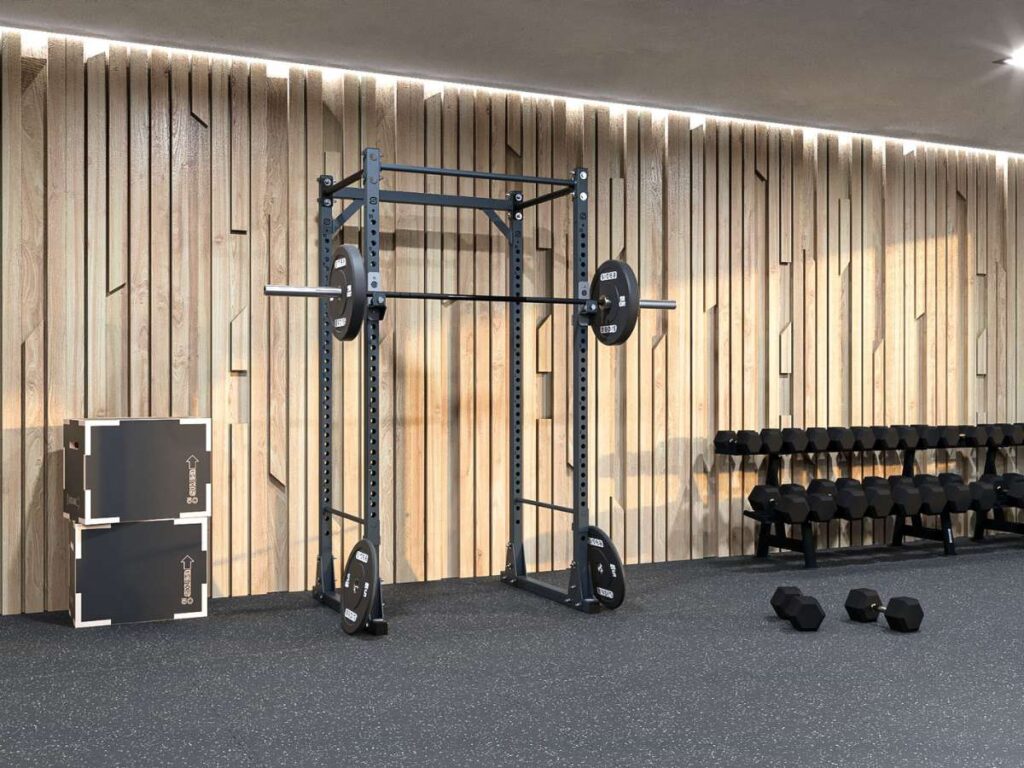
Squat Rack Space Requirements
Squat racks are the opposite: small, mobile, and flexible.
- Most models are two upright posts on a base
- Some have four posts, but still take up less space than a cage
- Great for tight corners or narrow lifting areas
They also move easier. If you ever need to rearrange your gym, a squat rack is less of a headache.
Running a smaller facility? Here’s what helps:
- Wall-mounted squat racks fold up when not in use
- Power cages, while bigger, often replace multiple machines if you use attachments
So it comes down to your layout. Do you have open floor space or do you need equipment that hugs the wall?
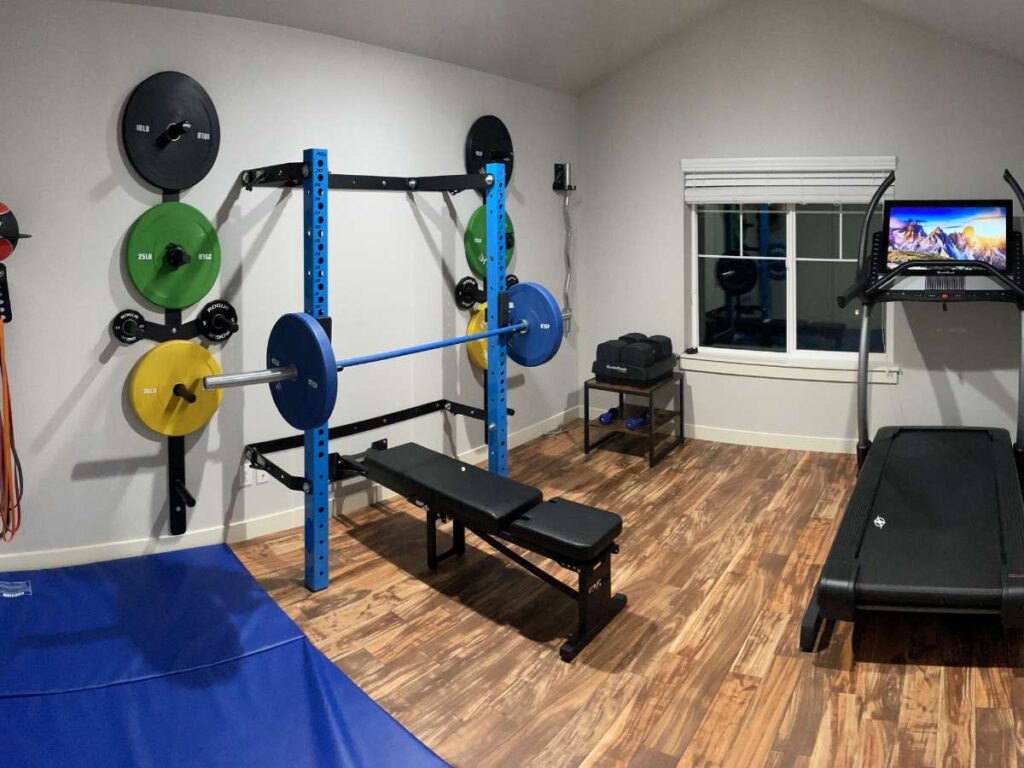
5. Durability and Stability
One of the first questions I ask clients is: how hard do your members train?
Because equipment might look great on day one but you’ll feel the difference in month six.
Let’s look at which option stands the test of time.
Power Cage
Power cages are built like tanks. They’re heavy. They stay in place. And they’re often made with thick, square steel tubing.
- Some can be bolted to the floor, which adds even more stability
- Others are heavy enough that they don’t budge, even under serious weight
- Many models support 1,000 lbs or more, depending on the gauge of steel
In my own gym setups, cages take the beating every day. Dropped bars. Heavy squats. No wobble. No problem.
If your members are pushing hard or training solo, this matters—just like having the right balance of free weights vs machines in your layout can define both training intensity and user confidence.
Squat Rack
Now let’s look at squat racks. They’re lighter and easier to move, which helps with portability. But that also means they can shift if not weighted or anchored.
- Basic models may wobble with heavier lifts
- Some need to be bolted down to handle serious weight
- They’re fine for moderate use, but max lifts may stress the structure
I’ve seen racks slide on slick floors. Not a huge risk—but not ideal either. Especially in a busy gym.
So if your setup gets intense, think about that base. Can it take what your members will throw at it?
6. Cost Breakdown
Money matters especially when you’re buying for a full gym setup. I’ve seen owners spend big on equipment that looked impressive but didn’t pay off. Let’s save you from that.
Initial Price
The starting price often catches people’s attention first.
Power cages usually cost more upfront. Why?
- Thicker steel
- Larger footprint
- More built-in features like pull-up bars or safety pins
A commercial-grade cage can easily run higher than a squat rack, depending on build quality and brand.
Squat racks, on the other hand, are simpler.
- Two uprights and a base
- Fewer materials
- Quicker to manufacture
That makes them easier on your budget, especially if you’re equipping multiple stations.
But remember—upfront cost isn’t the full story.
Long-Term Value
Here’s where power cages start to shine. They’re more than racks because they’re complete training stations.
You can:
- Add attachments
- Run multiple programs on one cage
- Replace other machines with one setup
This reduces the need for extra gear over time.
With squat racks, you may end up buying more:
- Spotter arms
- Adjustable benches
- Plate storage
- Even another rack if training demand grows
Distributor Insight
If you’re in the business of selling, think margins.
Power cages offer:
- More upsell potential (benches, dip bars, cable systems)
- Higher perceived value
- Stronger long-term customer retention
Squat racks ship easier and store smaller, which is great for moving inventory fast.
7. Add-On Compatibility
Buying a rack isn’t just about the frame. It’s about what you can add to it. I’ve worked with gyms that turned a single power cage into a full workout zone with just a few smart add-ons.
Let’s break down your options.
Power Cages
Power cages are built to grow with your gym. Just like smart gym membership strategies boost retention by offering variety, these add-ons keep your training zones fresh and multi-purpose.
Most commercial models accept a range of accessories:
- Cable systems (for lat pulldowns and rows)
- Landmine attachments (great for core work and presses)
- Dip stations
- Safety straps
- Pull-up bars with multiple grips
- Storage pegs for plates or bars
This means one cage can serve many users.
In group sessions, you can rotate between dips, squats, pull-ups, and rows—without needing multiple machines.
Over time, this saves space, money, and floor clutter.
Squat Racks
Squat racks are more limited.
They’re built for lifting, and that’s mostly what they do.
Some upgrades are possible:
- J-hooks (to hold the barbell)
- Spotter arms (for safety)
- Storage pegs for weights
But if you want pull-ups, cable work, or bodyweight training—you’ll need separate equipment.
Brand-Specific Compatibility
A quick word of caution: not every rack works with every add-on.
Some brands design their attachments to only fit their frames. Before you buy, double-check compatibility. Ask your supplier. Or test-fit if possible.
Conclusion
Now you know the difference. Power cage or squat rack? We covered safety, durability, add-ons, space, and who each one is best for.
This wasn’t just info. It was a guide to help you act.
I’ve been where you are staring at specs, second-guessing every choice.
But once you know what your space and your members need, the answer gets easier.
So what’s your next step?
Reach out to YR Fitness and let’s build a setup that actually works.
Related articles:




